From Arusha, the Serengeti National Park was about an eight hour drive. Another thing I found out about was that the Park entry fees were also quite expensive. They ranged from about $30 US to $50 per day. And there were additional fees for overnight camping about equally expensive. If you wanted to take a private car into the Ngorongoro Crater, it was $130 US per day.
My hotel tour manager offered me a package of four safari destinations and four nights accomodation, including all meals, park fees and transportation for $175 per day. It would be less expensive if he could find additional clients for this trip and more expensive if he couldn't.
The destinations that he suggested for my excursion were:
Tarangire National Park
Manyara National Park
Serengeti National Park
Ngorongoro Crater Conservation Area
I agreed, and the tour manager started looking for other clients for the trip. I gave him an extra day to look and he found a young Japanese man from Hokaido, Mr. Suzuki, who was interested in the first two days. The second two days I would be a solo safari client, and the fee went up to $200 per day.
Accompanying Mr. Suzuki and myself were two Tanzanians - one was a cook, and the other was the driver/guide. The vehicle we had was a modern four-wheel drive Toyoda van.
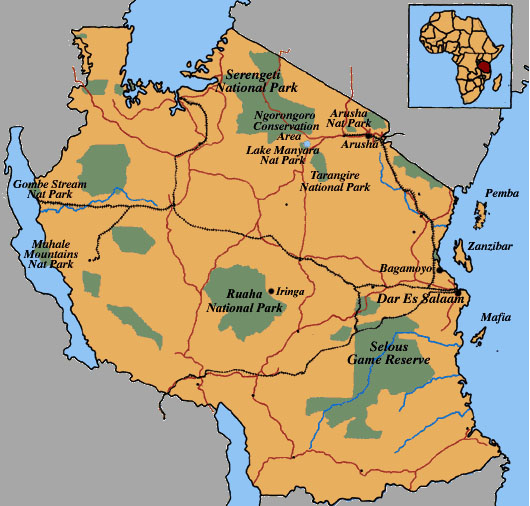
The first destination was to Tarangire National Park, which was a short two hour drive outside of Arusha. This park was very dry and we saw lots of elephants as we drove along the dry rolling hills.
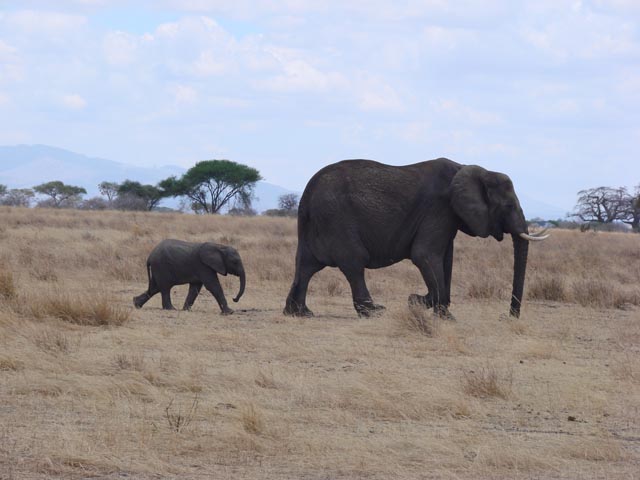
That night we stayed in the Rift Escarpment Hotel, which was owned by the tour company. It was more like a house with a half-dozen bedrooms than an actual hotel. The location was spectacular - It was on top of a 500 foot high hill that formed the edge of the Rift Valley. We could look below to the Rift Valley and see our next day's destination - Lake Manyara National Park.
The next days safari to Lake Manyara was quite different than Tarangire as the surrounding Rift Valley hillsides yielded many springs and all the vegetation was green and lush. The highlight of the day was the viewpoint next to the river emptying into Lake Manyara - it contained one pool which had over 100 hippos in it! ! !

I spent the that night back at the Rift Escarpement Hotel, while Mr. Suzuki made the road journey back to Arusha.
The next morning was a long road trip, and I was the lone client with my cook and driver. We headed west into the mountains and soon entered the Ngorongoro Crater conservation area. This was the only road to get to the other side of the mountain, but we had to check in anyway with the park rangers. At the edge of the crater, it was cloudy, misty and very cool. Roads were exclusively dirt. We got to a viewpoint area which we could look down into the crater floor (2,000 feet below) but we continued west and started decending to a low, treeless plain with broad views in every direction. This was "Massai-land" where the traditional Massai people had herded their cattle for generations.
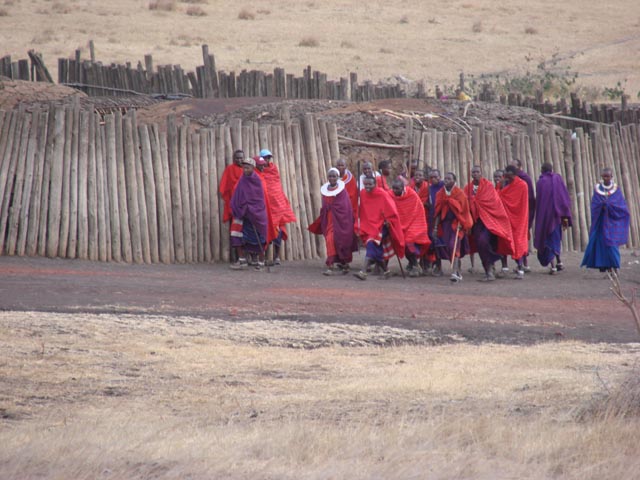
Massai village next to the highway
When we had finished desending from the mountain, we hit the flat Serengeti plain, but we were far from the Park entrance. The road was the worst road that I have ever experienced in my life - dirty and dusty with potholes inside of craters. When a vehicle passed us going the other direction, there was so much dust inside our van that I could bearly see. It was a VERY LONG four hour drive to the park visitor center. We checked in and I climbed to the top of the rocky hill and got a view of the area - there were hardly any trees in this part of the Serengeti. It was the dry season, so the long grasses were yellow. During the wet season, tens of thousands of animals migrate to this plain for the abundant vegetation and this is the peak tourist season.
I had the late afternoon for animal viewing and then we set up camp at the designated campsite. This was another "bush camp" where there were no fences to keep animals away during the night.
The next morning we got an early start in our driving the dirt roads of Serengeti. When the animal watching got slow, my driver would ask other tour guides how their viewing was as they passed by in their vehicles. I listened to one such exchange with my driver and another driver, but couldn' make anything out since I didn't understand swahili. My driver must have gotten some instructions, because he drove ahead for a few more minutes, stopped the van and looked around. Not seeing anyone in the vicinity, he took a right turn and started driving OFF-ROAD. This was highly illegal and could have resulted in a high fine and loss of his guiding license for my guide. We drove through the tall, sparce grass for about 100 meters when we came to a tall acacia tree. On the backside of the tree, asleep in a crook in the branches was a leapard! ! We surprised it when we approached and it raised its head. I took a single photo from my seat in the van, and my driver said "Let's get out of here!" It turned out to be one of my best photos of the trip.
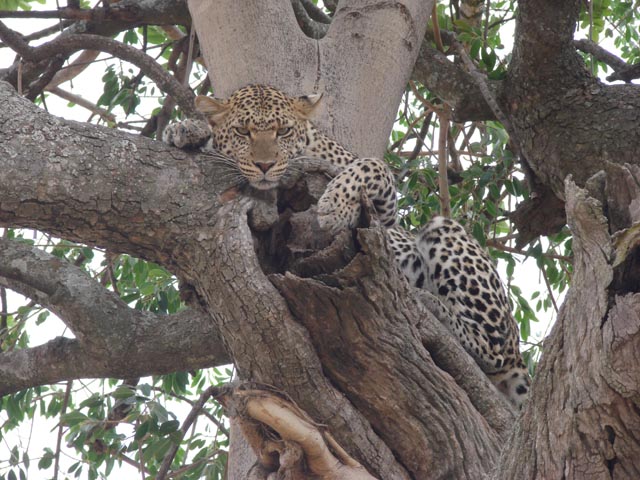
After lunch, we made our way out of Serengeti National Park and started on that terrible dirt road that lead back to Ngorongoro Crater. I really was not looking forward to this road trip. But the prevailing wind was from a different direction, so it wasn't quite as dusty as the previous day. I told my driver it was amazing that our Toyota van didn't come completely apart from all the shaking we were experiencing on this road. Around dinnertime, we found our campsite high on the mountain on the edge of the Ngorongoro Crater (map of location). Because of our elevation, the night was quite chilly.
Early the next morning, we drove the short distance to the single road descending the 2,000 feet to the crater floor. My driver told me about his 2 American lady clients that got scared because of this road and wanted to turn around after descending 1/2 way down - not possible since the road is only one way and there are no turn-around places on this narrow dirt road. No guardrails either to stop you from going off the road. We got down just fine.
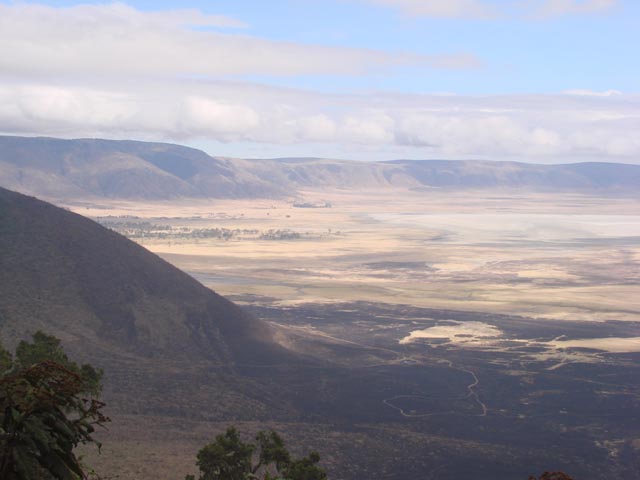
The weather was just about perfect this day, with some high clouds blocking the top of the mountain, but down below it was clear. There were wide expanses of grasslands, and you could see for miles in about every direction. There was a saline lake in the middle of the crater floor, and we saw a large flock of pink flamingos on the shore. I saw a cheetah sleeping on the ground, but it was so far away I couldn't get a good photo.
In the middle of the afternoon, we arrived at the single road which ascends the crater and takes you back to the top. This windy, dirt road appeared to me to be the most dangerous road that I have experienced. It climbed right on the edge of the crater wall, again without a guardrail for safety. It was about 15 feet wide and slippery from rain or springs and ascended at about a 15 - 20 degree slope most of the time. I was glad to make it to the top safely, but this road had my total attention during the experience, so that I didn't get photographs of this road.
From the edge of the crater rim, it was an uneventful five hour drive back to my hotel in Arusha. Altogether, it was a very memorable four day, four night trip.
The next day I had a plane ticket to take me to the capital of Malawi, Lilongwe. I departed from Kilimanjaro International Airport and stopped in Nairobi, Kenya for overnight. My flight from Nairobi to Malawi wasn't until the next morning. I slept at the airport which saved me from paying $50 US for a visa. It didn't seem like I should have to have pay for a visa, when I was just staying the night until my flight out the next morning. My sleep in the airport waiting area wasn't too uncomfortable and there were plenty of Africans also sharing the waiting area overnight.